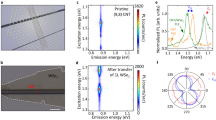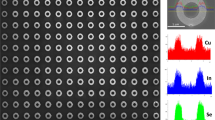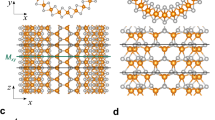Abstract
There has been renewed interest in solar concentrators and optical antennas for improvements in photovoltaic energy harvesting and new optoelectronic devices. In this work, we dielectrophoretically assemble single-walled carbon nanotubes (SWNTs) of homogeneous composition into aligned filaments that can exchange excitation energy, concentrating it to the centre of core–shell structures with radial gradients in the optical bandgap. We find an unusually sharp, reversible decay in photoemission that occurs as such filaments are cycled from ambient temperature to only 357 K, attributed to the strongly temperature-dependent second-order Auger process. Core–shell structures consisting of annular shells of mostly (6,5) SWNTs (Eg=1.21 eV) and cores with bandgaps smaller than those of the shell (Eg=1.17 eV (7,5)–0.98 eV (8,7)) demonstrate the concentration concept: broadband absorption in the ultraviolet–near-infrared wavelength regime provides quasi-singular photoemission at the (8,7) SWNTs. This approach demonstrates the potential of specifically designed collections of nanotubes to manipulate and concentrate excitons in unique ways.
This is a preview of subscription content, access via your institution
Access options
Subscribe to this journal
Receive 12 print issues and online access
$259.00 per year
only $21.58 per issue
Buy this article
- Purchase on Springer Link
- Instant access to full article PDF
Prices may be subject to local taxes which are calculated during checkout




Similar content being viewed by others
References
Currie, M. J., Mapel, J. K., Heidel, T. D., Goffri, S. & Baldo, M. A. High-efficiency organic solar concentrators for photovoltaics. Science 321, 226–228 (2008).
Yoon, J. et al. Ultrathin silicon solar microcells for semitransparent, mechanically flexible and microconcentrator module designs. Nature Mater. 7, 907–915 (2008).
Mühlschlegel, P., Eisler, H-J., Martin, O. J. F., Hecht, B. & Pohl, D. W. Resonant optical antennas. Science 308, 1607–1609 (2005).
Taminiau, T. H., Stefani, F. D., Segerink, F. B. & van Hulst, N. F. Optical antennas direct single-molecule emission. Nature Photon. 2, 234–237 (2008).
van de Lagemaat, J. et al. Organic solar cells with carbon nanotubes replacing In2O3:Sn as the transparent electrode. Appl. Phys. Lett. 88, 233503 (2006).
Schuller, J. A., Taubner, T. & Brongersma, M. L. Optical antenna thermal emitters. Nature Photon. 3, 658–661 (2009).
Lin, M. F. Optical spectra of single-wall carbon nanotube bundles. Phys. Rev. B 62, 13153–13159 (2000).
Yu, Z. & Brus, L. Rayleigh and Raman scattering from individual carbon nanotube bundles. J. Phys. Chem. B 105, 1123–1134 (2001).
Wang, F. et al. Interactions between individual carbon nanotubes studied by Rayleigh scattering spectroscopy. Phys. Rev. Lett. 96, 167401 (2006).
Tan, P. H. et al. Photoluminescence spectroscopy of carbon nanotube bundles: Evidence for exciton energy transfer. Phys. Rev. Lett. 99, 137402 (2007).
Qian, H. et al. Exciton transfer and propagation in carbon nanotubes studied by near-field optical microscopy. Phys. Status Solidi B 245, 2243–2246 (2008).
Kato, T. & Hatakeyama, R. Exciton energy transfer-assisted photoluminescence brightening from freestanding single-walled carbon nanotube bundles. J. Am. Chem. Soc. 130, 8101–8107 (2008).
Lefebvre, J. & Finnie, P. Photoluminescence and Förster resonance energy transfer in elemental bundles of single-walled carbon nanotubes. J. Phys. Chem. C 113, 7536–7540 (2009).
Delaney, P., Choi, H. J., Ihm, J., Louie, S. G. & Cohen, M. L. Broken symmetry and pseudogaps in ropes of carbon nanotubes. Phys. Rev. B 60, 7899–7904 (1999).
Kim, W-J., Nair, N., Lee, C. Y. & Strano, M. S. Covalent functionalization of single-walled carbon nanotubes alters their densities allowing electronic and other types of separation. J. Phys. Chem. C 112, 7326–7331 (2008).
Arnold, M. S., Green, A. A., Hulvat, J. F., Stupp, S. I. & Hersam, M. C. Sorting carbon nanotubes by electronic structure using density differentiation. Nature Nanotech. 1, 60–65 (2006).
Förster, T. 10th Spiers Memorial Lecture. Transfer mechanisms of electronic excitation. Discuss. Faraday Soc. 27, 7–17 (1959).
Scardaci, V. et al. Carbon nanotubes for ultrafast photonics. Phys. Status Solidi B 244, 4303–4307 (2007).
Hertel, T., Fasel, R. & Moos, G. Charge-carrier dynamics in single-wall carbon nanotube bundles: A time-domain study. Appl. Phys. A 75, 449–465 (2002).
Lauret, J-S. et al. Ultrafast carrier dynamics in single-wall carbon nanotubes. Phys. Rev. Lett. 90, 057404 (2003).
Tang, J. et al. Assembly of 1D nanostructures into sub-micrometer diameter fibrils with controlled and variable length by dielectrophoresis. Adv. Mater. 15, 1352–1355 (2003).
Wang, F., Dukovic, G., Brus, L. E. & Heinz, T. F. Time-resolved fluorescence of carbon nanotubes and its implication for radiative lifetimes. Phys. Rev. Lett. 92, 177401 (2004).
Perebeinos, V., Tersoff, J. & Avouris, P. Radiative lifetime of excitons in carbon nanotubes. Nano Lett. 5, 2495–2499 (2005).
Qian, H. et al. Exciton energy transfer in pairs of single-walled carbon nanotubes. Nano Lett. 8, 1363–1367 (2008).
Uchida, T., Tachibana, M. & Kojima, K. Thermal relaxation kinetics of defects in single-wall carbon nanotubes. J. Appl. Phys. 101, 084313 (2007).
Hagen, A. et al. Exponential decay lifetimes of excitons in individual single-walled carbon nanotubes. Phys. Rev. Lett. 95, 197401 (2005).
Trautz, M. Das Gesetz der Reaktionsgeschwindigkeit und der Gleichgewichte in Gasen. Bestätigung der Additivität von Cv-3/2R. Neue Bestimmung der Integrationskonstanten und der Moleküldurchmesser. Z. Anorg. Allg. Chem. 96, 1–28 (1916).
Manzoni, C. et al. Intersubband exciton relaxation dynamics in single-walled carbon nanotubes. Phys. Rev. Lett. 94, 207401 (2005).
Vyazovkin, S. Kinetic concepts of thermally stimulated reactions in solids: A view from a historical perspective. Int. Rev. Phys. Chem. 19, 45–60 (2000).
Jost, W. The theory of electrolytical charge and diffusion in crystals. II. Z. Phys. Chem. A 169, 129–134 (1934).
Zeldowitsch, J. B. On the theory of reactions on powders and porous substances. Acta Phys.-Chim. URSS 10, 583–592 (1939).
O’Connell, M. J. et al. Band gap fluorescence from individual single-walled carbon nanotubes. Science 297, 593–596 (2002).
Buehler, M. J. Mesoscale modeling of mechanics of carbon nanotubes: Self-assembly, self-folding, and fracture. J. Mater. Res. 21, 2855–2869 (2006).
Kroeze, J. E., Koehorst, R. B. M. & Savenije, T. J. Singlet and triplet exciton diffusion in a self-organizing porphyrin antenna layer. Adv. Funct. Mater. 14, 992–998 (2004).
Gottfried, D. S., Steffen, M. A. & Boxer, S. G. Large protein-induced dipoles for a symmetric carotenoid in a photosynthetic antenna complex. Science 251, 662–665 (1991).
Abdula, D. & Shim, M. Performance and photovoltaic response of polymer-doped carbon nanotube p–n diodes. ACS Nano 2, 2154–2159 (2008).
Bibby, T. S., Nield, J., Partensky, F. & Barber, J. Oxyphotobacteria: Antenna ring around photosystem I. Nature 413, 590 (2001).
Green, B. R. & Parson, W. W. Light-Harvesting Antennas in Photosynthesis, Vol. 13 (Kluwer Academic, 2003).
Acknowledgements
M.S.S. is grateful for the NSF Career Award and the Sloan Fellowship for supporting this work. A grant to M.S.S. from the Dupont-MIT Alliance is appreciated. J-H.H. acknowledges support from the Korea Research Foundation (MOEHRD, KRF-2006-214-D00117). W-J.K. appreciates support from Kyungwon University. J.H.C. expresses his gratitude to Purdue University for financial support. The authors thank M. Zheng for useful discussions.
Author information
Authors and Affiliations
Contributions
M.S.S. and J-H.H. conceived and designed the experiments. J-H.H. and G.L.C.P. carried out the experiments and theoretical calculation, and J-H.H., G.L.C.P. and M.S.S. analysed the data. D.A.H. designed and built the in-house dual-channel microscope. R.M., D.A.H., W-J.K., P.W.B., C.Y.L., J.H.C., M-H.H., C.S. and C.F. partly assisted in doing experiments and commented on the results. J-H.H., G.L.C.P. and M.S.S. wrote the paper.
Corresponding author
Ethics declarations
Competing interests
The authors declare no competing financial interests.
Supplementary information
Supplementary Information
Supplementary Information (PDF 966 kb)
Rights and permissions
About this article
Cite this article
Han, JH., Paulus, G., Maruyama, R. et al. Exciton antennas and concentrators from core–shell and corrugated carbon nanotube filaments of homogeneous composition. Nature Mater 9, 833–839 (2010). https://doi.org/10.1038/nmat2832
Received:
Accepted:
Published:
Issue Date:
DOI: https://doi.org/10.1038/nmat2832
This article is cited by
-
Resonant exciton transfer in mixed-dimensional heterostructures for overcoming dimensional restrictions in optical processes
Nature Communications (2023)
-
Potential of carbon nanotubes in algal biotechnology
Photosynthesis Research (2015)
-
Plant nanobionics approach to augment photosynthesis and biochemical sensing
Nature Materials (2014)
-
Strain-engineered artificial atom as a broad-spectrum solar energy funnel
Nature Photonics (2012)
-
Virus-templated self-assembled single-walled carbon nanotubes for highly efficient electron collection in photovoltaic devices
Nature Nanotechnology (2011)



